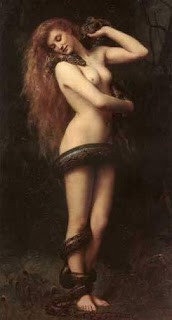arte e mitologia - Art and mythology
Il mito pelasgico della creazione
All'inizio Eurinome, Dea di tutte le cose, emerse nuda dal Caos e non trovò nulla di solido per posarvi i piedi: divise allora il mare dal cielo e intrecciò sola una danza sulle onde. Sempre danzando si diresse verso sud e il vento che turbinava alle sue spalle le parve qualcosa di nuovo e di distinto; pensò dunque di iniziare con lui l'opera della creazione. Si voltò all'improvviso, afferrò codesto Vento del Nord e lo soffregò tra le mani: ecco apparire il grande serpente Ofione. Eurinome danzava per scaldarsi, danzava con ritmo sempre più selvaggio finchè Ofione, acceso di desiderio, avvolse nelle sue spire le membra della dea ed a lei si accoppiò. Ora il vento del nord, detto anche Borea, è un vento fecondatore; spesso infatti le cavalle, accarezzate dal suo soffio, concepiscono puledri senza l'aiuto di uno stallone. E così anche Eurinome rimase incinta.*
Plinio, Storia naturale IV 35 e VIII 67; Omero, Iliade XX 223
The myth of creation Pelasgian
Early Eurynome, Goddess of all things, emerged naked from Chaos, and found nothing solid posarvi feet: then divided the sea from the sky and wove a dance on the waves alone. Always dancing headed south and the wind swirled behind her seemed something new and distinct, therefore, thought to start with him the work of creation. He turned suddenly, grabbed the North Wind and rubbed his hands here is the great serpent Ophion appear. Eurynome danced to warm up, dancing with the rhythm more and more wild until Ophion, lit with desire, wrapped in its coils the limbs of the goddess and she mated. Now the north wind, Boreas also called, is a wind fertilizing, often because the mares, caressed by his breath, foals conceived without the help of a stallion. And so Eurynome became pregnant .*
Plinio, Natural History, IV and VIII 35 67; Omero, Iliad XX 223
Eurinome ed il serpente Ofione
All'inizio Eurinome, Dea di tutte le cose, emerse nuda dal Caos e non trovò nulla di solido per posarvi i piedi: divise allora il mare dal cielo e intrecciò sola una danza sulle onde. Sempre danzando si diresse verso sud e il vento che turbinava alle sue spalle le parve qualcosa di nuovo e di distinto; pensò dunque di iniziare con lui l'opera della creazione. Si voltò all'improvviso, afferrò codesto Vento del Nord e lo soffregò tra le mani: ecco apparire il grande serpente Ofione. Eurinome danzava per scaldarsi, danzava con ritmo sempre più selvaggio finchè Ofione, acceso di desiderio, avvolse nelle sue spire le membra della dea ed a lei si accoppiò. Ora il vento del nord, detto anche Borea, è un vento fecondatore; spesso infatti le cavalle, accarezzate dal suo soffio, concepiscono puledri senza l'aiuto di uno stallone. E così anche Eurinome rimase incinta.*
Plinio, Storia naturale IV 35 e VIII 67; Omero, Iliade XX 223
The myth of creation Pelasgian
Early Eurynome, Goddess of all things, emerged naked from Chaos, and found nothing solid posarvi feet: then divided the sea from the sky and wove a dance on the waves alone. Always dancing headed south and the wind swirled behind her seemed something new and distinct, therefore, thought to start with him the work of creation. He turned suddenly, grabbed the North Wind and rubbed his hands here is the great serpent Ophion appear. Eurynome danced to warm up, dancing with the rhythm more and more wild until Ophion, lit with desire, wrapped in its coils the limbs of the goddess and she mated. Now the north wind, Boreas also called, is a wind fertilizing, often because the mares, caressed by his breath, foals conceived without the help of a stallion. And so Eurynome became pregnant .*
Plinio, Natural History, IV and VIII 35 67; Omero, Iliad XX 223
Eurinome ed il serpente Ofione


